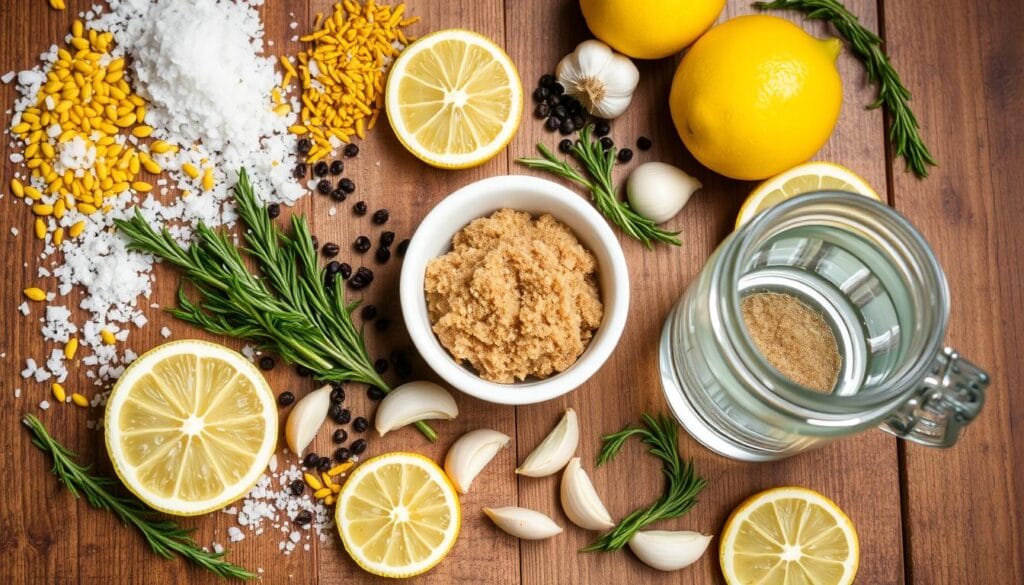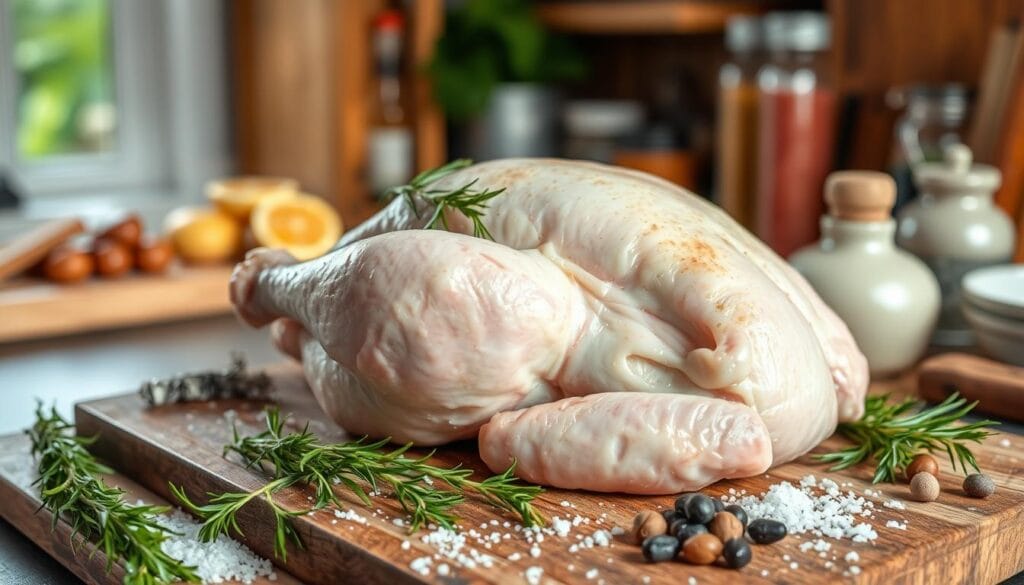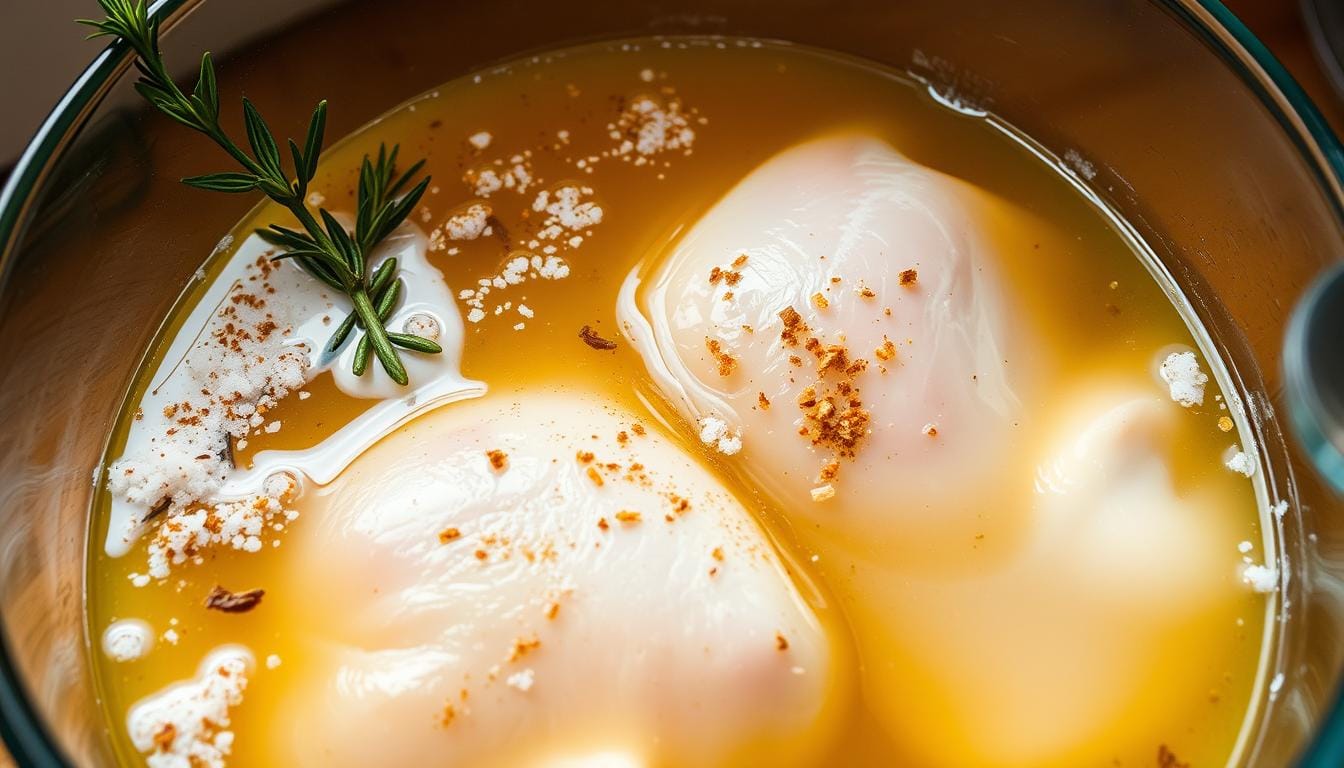What is Brining Chicken and How Does It Work?
I’ve always looked for the best way to make my chicken dishes stand out. Then, I discovered brining chicken. It’s like a secret trick that makes ordinary chicken taste amazing. When you eat brined chicken, the flavors and tenderness are incredible.
In this article, we’ll explore the magic of brining. You’ll learn why it makes chicken so delicious. Whether you’re new to cooking or experienced, you’ll be amazed at how brining can change your chicken dishes. So, let’s start and find out how to make your chicken the most tender and flavorful it can be.
Table of Contents
Understanding the Science Behind Chicken Brining
Brining chicken before cooking is a popular method. It boosts flavor and makes the meat more tender and moist. But why does it work so well? Let’s explore the science behind chicken brining.
Osmosis and Salt Concentration
Osmosis is key to understanding brining. When chicken is in a brine solution, the salt level is higher than in the chicken’s cells. This pulls water from the chicken into the brine. This makes the meat tender and juicy.
Protein Modification Process
Brining also changes the chicken’s proteins. The salt in the brine makes proteins more flexible and better at holding moisture. This is why brined chicken is so tender and juicy.
Chemical Changes During Brining
While brining, the chicken undergoes more changes. The salt breaks down muscle fibers, making them tender. It also brings out the chicken’s natural flavors, as the meat absorbs the brine’s seasonings.
Knowing the science behind chicken brining unlocks its full potential. Whether you’re using a brine solution for chicken or brining chicken before cooking, understanding these principles leads to moist and flavorful results.
| Mechanism | Effect on Chicken |
|---|---|
| Osmosis | Draws water into the meat, increasing moisture and tenderness |
| Protein Modification | Denatures and unfolds proteins, improving texture and water retention |
| Chemical Changes | Breaks down muscle fibers, enhances natural flavors |
“Brining is a simple yet powerful technique that can transform ordinary chicken into a juicy, flavorful masterpiece.”
What Is Brining Chicken: A Complete Guide
Brining chicken is a simple yet effective technique that changes how you prepare and enjoy this versatile protein. Whether you’re a seasoned home chef or a novice in the kitchen, learning about brining can make your chicken dishes better. In this guide, we’ll cover the basics of what is brining chicken and give you the key to becoming a master of the chicken brine recipe.
At its core, brining chicken means soaking the meat in a saltwater solution, often with other flavorful ingredients. This step before cooking greatly improves the chicken, making it juicier, more tender, and flavorful.
- The Science Behind Brining: Brining uses osmosis to let the chicken soak up salt and seasonings, making it moist and seasoned.
- Wet Brining vs. Dry Brining: There are two main ways to brine chicken – wet brining in a saltwater solution or dry brining with a dry rub of salt and spices.
- Brine Ingredients: A chicken brine recipe can include herbs, spices, and aromatics to give your chicken the flavors you want.
By understanding the science behind brining and mastering the techniques, you’ll always make juicy, flavorful chicken. This will impress your family and friends. Explore the world of brining and unlock the full potential of your poultry dishes.
| Brining Method | Advantages | Considerations |
|---|---|---|
| Wet Brining |
|
|
| Dry Brining |
|
|
Brining your chicken, no matter the method, is a surefire way to improve your cooking. It ensures juicy, flavorful results every time. Explore the world of what is brining chicken and discover the endless possibilities of the chicken brine recipe.
“Brining is the secret weapon of the home cook. It’s a simple technique that can transform even the blandest of chicken breasts into a moist, flavorful masterpiece.”
Types of Brining Methods for Poultry
There are several ways to brine chicken and other poultry. You can try traditional wet brining, modern dry brining, or injection brining. Each method has its own benefits and uses, so let’s dive into them.
Traditional Wet Brining Technique
Wet brining is the classic method. It involves soaking the poultry in a saltwater solution for a long time. This makes the meat moist and flavorful. It’s great for whole chickens or turkey because it reaches deep into the meat.
Modern Dry Brining Approach
Dry brining is different. It involves rubbing a salt-based seasoning on the meat’s surface. This method draws out moisture, which then absorbs the flavors. It’s quick and easy, perfect for smaller cuts like chicken breasts or thighs.
Injection Brining Method
Injection brining uses a special tool to inject brine into the meat. It’s efficient and good for large cuts like whole turkeys. But, it needs special equipment and takes more time than other methods.
Choosing a brining method helps improve your poultry’s moisture, tenderness, and flavor. Knowing the different methods helps you pick the best one for your needs.
| Brining Method | Advantages | Disadvantages |
|---|---|---|
| Wet Brining |
|
|
| Dry Brining |
|
|
| Injection Brining |
|
|
By learning about wet brining poultry and dry brining chicken, you can pick the best method for you. This ensures your poultry is always moist, flavorful, and perfectly cooked.
Essential Ingredients for the Perfect Chicken Brine
Making a tasty chicken brine is like a craft that makes your chicken taste better. The secret is in the right mix of ingredients. These ingredients turn simple chicken into a dish to remember. Let’s look at what makes a great brine ingredients for chicken and chicken brine recipe.
Salt is at the core of a good brine. It pulls moisture into the chicken, making it juicy and tender. Salt also changes the chicken’s protein structure, making it taste better.
Sugar is also key in the chicken brine recipe. It adds sweetness to balance out the savory flavors. Salt and sugar together create a flavor that’s both savory and sweet.
| Ingredient | Role in the Brine |
|---|---|
| Salt | Draws moisture into the chicken, enhances protein structure, and contributes to overall flavor. |
| Sugar | Adds a touch of sweetness to balance the savory elements of the brine. |
| Herbs and Spices | Infuse the chicken with a variety of aromatic and flavorful notes, such as rosemary, thyme, black pepper, and bay leaves. |
| Acidic Ingredients (e.g., vinegar, lemon juice) | Help to tenderize the chicken and add depth of flavor. |
A great brine ingredients for chicken also includes herbs and spices. These add flavors like rosemary and black pepper. Acidic ingredients like vinegar or lemon juice make the chicken tender and add flavor.
“The secret to a truly exceptional chicken brine recipe lies in the perfect balance of these key ingredients. Each component plays a crucial role in creating a mouthwatering and memorable dining experience.”

Step-by-Step Guide to Wet Brining Chicken
Wet brining turns ordinary chicken into a juicy, flavorful dish. It works whether you brine overnight or for a few hours. Let’s explore how to make the perfect brine and brine times and temperatures.
Preparing Your Brine Solution
Begin by mixing a brine solution with salt, sugar, and water. A basic recipe uses 1/4 cup of salt and sugar for every 4 cups of water. You can adjust this to taste. Add herbs, spices, or citrus for extra flavor.
Proper Brining Times and Temperatures
- Brine chicken for 4 to 12 hours in the fridge. Don’t brine for more than 24 hours to avoid too much salt.
- Keep the brine at 35°F to 40°F (2°C to 4°C) to stop bacteria from growing. Use ice packs or a cooler if needed.
Safety Considerations During Brining
- Make sure the chicken is fully covered in brine.
- Use a food-safe container, like a big plastic bag or a non-reactive pot, for the chicken and brine.
- Throw away the brine after and clean the container well to avoid contamination.
By following these steps, you’ll get delicious wet brined chicken. It’s juicy, flavorful, and sure to impress. Enjoy your brining chicken overnight or wet brining poultry success!
Mastering Dry Brining Techniques
Looking to make your chicken dishes better? Learning dry brining is a big step up. Dry brining chicken turns even the most basic chicken into something juicy and full of flavor. It’s different from wet brining because it uses salt to slowly season the meat, making the flavors more intense and balanced.
To dry brine chicken breasts well, you need to spread the salt evenly. Use a coarse salt like kosher or sea salt and cover the whole chicken. Make sure to get the thicker parts like breasts and thighs well coated. Then, put the chicken on a wire rack over a baking sheet and chill it, uncovered, for at least 4 hours. For even better results, brine it for up to 24 hours.
- The longer you brine, the stronger the flavor will be. For a light taste, brine for 4-6 hours. For a more intense flavor, brine for 12-24 hours.
- Before cooking, pat the chicken dry with paper towels. This helps keep the flavors concentrated.
Dry brining works with many chicken cuts, from whole birds to pieces. Try different salt amounts and brining times to find what you like best.

“Dry brining is the secret to juicy, flavorful chicken every time. The slow infusion of salt transforms the meat, locking in moisture and amplifying the natural flavors.”
With a bit of practice, you’ll get the hang of dry brining chicken. It’s a simple yet powerful technique that can take your chicken dishes to the next level. Start experimenting and see the difference it makes in your cooking.
Common Brining Mistakes to Avoid
Brining chicken can make a big difference in your cooking. But, it’s key to avoid common mistakes to get juicy and tasty results. We’ll look at the most common errors and how to avoid them.
Oversalting and Timing Errors
One big mistake is using too much salt in the brine. This can make your chicken too salty. The right mix is about 1/4 cup of salt for every 1 cup of water. Make sure to measure carefully to avoid this.
Also, don’t leave the chicken in the brine too long. This can make it too salty. Stick to the recommended brining time to avoid this problem.
Temperature Control Issues
Temperature is very important when brining. If it’s too warm, bacteria can grow. If it’s too cold, the chicken won’t soak up flavors well. Keep the brine between 35°F and 40°F for the best results.
Container Selection Problems
Choosing the right container is crucial. Don’t use aluminum or cast iron as they can give off-flavors. Instead, use non-reactive containers like plastic, glass, or stainless steel.
By avoiding these mistakes and following best practices, you can make your chicken juicy and flavorful. A good brine solution for chicken is the key to a great meal.
Benefits of Brining Your Chicken
Brining your chicken can change your cooking game. It makes your dishes better, whether you’re a pro or just starting. Knowing how to brine can really improve your chicken’s taste and texture.
One big plus of brining is keeping the chicken moist. By soaking it in a salt-water mix, the meat holds onto more moisture. This makes the chicken juicier and more tender, especially for lean cuts.
Brining also adds a richer flavor to your chicken. The salt in the brine seasons the meat from the inside. This is great for adding depth to your dishes, especially when you use spices or herbs.
Another benefit is more even cooking. Brined chicken cooks better, avoiding dry spots. This means your chicken will be more consistent in texture and taste.
| Benefit | Description |
|---|---|
| Moisture Retention | Brining helps the chicken absorb and trap additional moisture, resulting in a juicier and more tender final product. |
| Flavor Enhancement | The salt in the brine penetrates the meat, seasoning it from the inside out and creating a more robust flavor profile. |
| Consistent Cooking | Brined chicken is less prone to overcooking or uneven doneness, ensuring a more uniform texture and appearance. |
Learning about brining opens up new flavors and textures in your cooking. It’s worth the effort for every delicious bite, whether you’re grilling, roasting, or baking.
Best Cuts of Chicken for Brining
Not all chicken cuts are the same when it comes to brining. The right cut can make a big difference in how your chicken turns out. Here are the top chicken cuts that are perfect for brining.
Chicken Breasts
Chicken breasts are great for brining chicken breasts. They can get dry if not brined. But, a good brine keeps them moist and adds flavor.
Whole Chickens
Brining a whole chicken is a game-changer. It makes the meat juicy and the skin crispy. Just remember to adjust the brining time for a whole bird.
Chicken Thighs
Chicken thighs are a hit with dark meat lovers. They stay juicy because of their fat and connective tissue. Brining makes them even more tender and flavorful.
| Chicken Cut | Brining Suitability | Key Considerations |
|---|---|---|
| Chicken Breasts | Excellent | Lean meat benefits from added moisture and flavor |
| Whole Chicken | Excellent | Adjust brining time to accommodate larger size |
| Chicken Thighs | Excellent | Dark meat is less prone to drying out |
Brining is key to making your chicken juicy and full of flavor. Try different cuts and brining methods to find what works best for you.
How to Cook Brined Chicken Properly
Cooking brined chicken needs a different approach than regular chicken. To get it moist and flavorful, focus on temperature and cooking methods.
Temperature Guidelines
The chicken must reach 165°F (74°C) to be fully cooked and safe. But, don’t overcook it. The extra moisture can make the meat soggy if it gets too hot. Always check the chicken with a meat thermometer.
Cooking Methods for Brined Chicken
Brined chicken works well with roasting, grilling, and pan-searing. Roasting is great for caramelizing the skin and keeping the juices in. Grilling adds a smoky taste and a crispy outside. Pan-searing on the stovetop and then finishing in the oven is quick and tasty.

